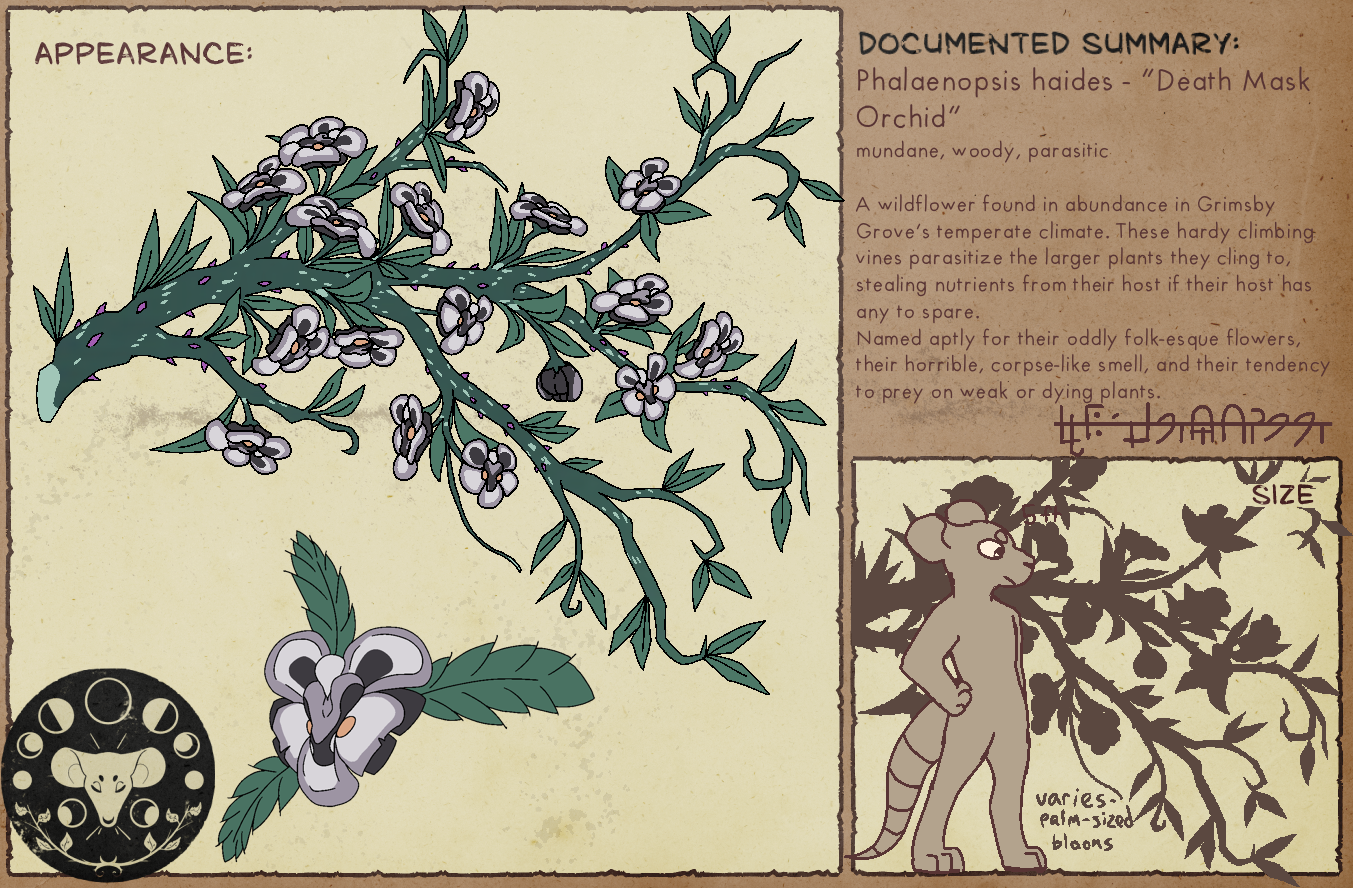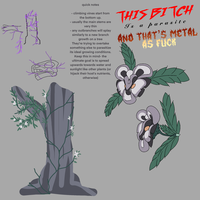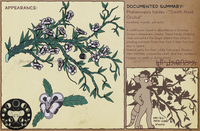Death Mask Orchids
GrimsbyGroveArchives
- Created
- 1 month, 28 days ago
- Creator
- GrimsbyGroveArchives
- Favorites
- 2
Profile
Death Mask Orchids

Phalaenopsis Haides: Death Mask Orchids, Strangling Orchids, Azalhai’s Eyes
perennial woody plant, mundane, parasitic
varies based on environment, substrate and age, with generally palm-sized blooms
Temperate climates with warm harvest seasons and ether-rich soil, typically with lush, pre-existing plant growth
Year-round— growth rate peaks around the middle of autumn, and valleys in the cold winter months
BIOLOGY OVERVIEW
Phalaenopsis Haides, colloquially referred to as the ‘Death Mask Orchid’, is a new world member of the Phalaenopsis genus that has evolved into a semi-parasitic liana species. It has come to be associated with the idea of death due to its habit of growing rapidly over dying plants and fresh corpses.
The seed of Phalaenopsis Haides leaves its mother plant by way of transportation through the air, typically by way of attachment to a small animal. When the animal brushes up against a seeding orchid’s seed pod, seeds will become dislodged from the pod and stick to the animal’s body and legs. They will remain there as the animal goes about its business until they are loosened and fall to the ground, where they will go dormant until ready to take root.
Typically the signal that a seed uses to begin germination is the presence of a high amount of ether content present in the ground around it- whether this be from the spilled blood of a fallen megafauna, or a sickly tree that is hemorrhaging ether. After growing a rudimentary root system to support itself, Phalaenopsis haides’s roots will sprout upwards and begin growing towards the most potent source of ether nearby.
Its thick roots climb quickly over any vertical surface in order to maximize its sunlight intake, worming its way into the flesh of nearby plants with weakened immune systems, sapping their nutrients and ether in order to support itself. It does the same with corpses, making it a pioneer species in the process of decomposition. It will even grow over walls, buildings, and other abiotic, sheer surfaces– though oftentimes these specimens of Phalaenopsis Haides are much smaller, with more complex inground root systems and stunted aboveground growth. Whenever it reaches an area with an appropriate amount of sunlight, it will quickly sprout stems and leaves.
The rapid growth Phalaenopsis Haides experiences is overall unusual in the realm of mundane flora, expanding from seed to flowering within only a few weeks of leaving dormancy. The flowers of this species are similarly unusual, with ten thick petals that share a passing resemblance to the face of a folk- with two stamen that mimic eyes. It is theorized that this ‘false face’ pattern was evolved in order to dissuade potential predators - such as the ever-expanding Bugterria species or the voracious Cuddlebugs - from consuming the plant. The stamen of the flower also produce a horrible, ‘corpse-like’ smell, likened to the smell of rotting flesh. While most species steer away from the vines due to their smell, there exists a special species of butterfly who cannot exist without Phalaenopsis Haides – and being the plant’s primary pollinator and propagator, it is likely Phalaenopsis Haides would not be such a successful species without the assistance of this butterfly.
The presence of wild death masks on your own plants may be a symptom of a greater issue within your plant’s health; if you are seeing death mask growth within your garden, it may be time to consult a chloromancer for a wellness check.
COMMON USES
USED FOR
Decoration, food, shelter
Death masks are an important staple of folk culture, especially within the Adventurer’s Guild. Many folk predators instinctively avoid the smell of death masks, making them safe havens for folk within their borders. Some folk have even gone so far as to have evolved to enjoy the smell of death masks – though this is definitely not the case for the majority, and any adventurer’s standard survival kit will include a few pairs of noseplugs for the unfortunate explorer that has to take shelter among them.
By removing the stamen of the flowers, the plant can be ‘de-scented’, though this comes at the cost of neutering said plant. Cuttings of the death mask can survive if given enough moisture and ether, eventually growing their own root systems and surviving as an individual apart from the mother plant. Folk will take advantage of this by pruning wild death masks and placing the emancipated cuttings onto trellises to grow on their own. Folk-grown death masks are oftentimes de-scented, and some neighborhoods even mandate that you de-scent your death masks to prevent discomfort and nausea among neighbors.
The stamen of a descented death mask can be repurposed into a snack. Removed stamens are washed, spiced and fried in light oil, resulting in a tasty, smelly, treat known as “eyepoppers”.
HISTORIC AND CULTURAL EXPERIENCES
Be merry in festivity, Azalhai be with you, Azalhai is watching, Beware the road ahead
Death masks are an important staple of folk culture, especially within the Adventurer’s Guild. Many folk predators instinctively avoid the smell of death masks, making them safe havens for folk within their borders. Some folk have even gone so far as to have evolved to enjoy the smell of death masks – though this is definitely not the case for the majority, and any adventurer’s standard survival kit will include a few pairs of noseplugs for the unfortunate explorer that has to take shelter among them.
By removing the stamen of the flowers, the plant can be ‘de-scented’, though this comes at the cost of neutering said plant. Cuttings of the death mask can survive if given enough moisture and ether, eventually growing their own root systems and surviving as an individual apart from the mother plant. Folk will take advantage of this by pruning wild death masks and placing the emancipated cuttings onto trellises to grow on their own. Folk-grown death masks are oftentimes de-scented, and some neighborhoods even mandate that you de-scent your death masks to prevent discomfort and nausea among neighbors.
The stamen of a descented death mask can be repurposed into a snack. Removed stamens are washed, spiced and fried in light oil, resulting in a tasty, smelly, treat known as “eyepoppers”.

